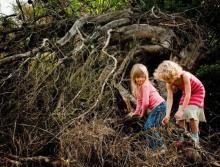
David Hawkins and Karen Payne founded Wild Zones as a consulting service to assist communities “concerned with fostering children's free play in nature and creating intergenerational projects that build community.”1 Wild Zones or “Create-with-Nature” Zones are open-ended natural play spaces for self-directed play, creativity, learning, and socializing among children, adolescents, and adults.2 Differing from parks and nature reserves, Wild Zones “afford the opportunity to do practical and adventurous things, such as building shelters, making trails, climbing trees, damming creeks, creating sculptures from natural objects and other types of exploration and free play.”3
David has over 20 years’ experience as a counselor, teacher, and children’s advocate working in schools, adventure playgrounds, and government programs. He worked with troubled children in London for 10 years and was the founding project manager at a multi-racial school in Berkeley, California, where over nine hundred 11-13 year olds transformed a vacant lot into a productive garden. The Edible Schoolyard at Martin Luther King Middle School had the vision “to improve the children’s nutrition and understanding of ecology by creating a garden, a teaching kitchen, and gradually develop a school lunch program serving fresh locally-grown produce.”4
Karen has worked for over 25 years focusing on issues of social and environmental justice, violence prevention, anti-racism, community development, and social change philanthropy.5
Areas that adopt the Wild Zones philosophy can include elements, such as water, mud, sand, plants, trees, flowers, and sticks, which can be used to create tree houses, shelters, dams, walls, sculptures, teepees, or any structure the imagination can conceive.6 Adults or adolescents trained in facilitating safe and open-ended play called play “guardians” are on hand to assist in the nature play. Wild Zones can be located on marginal land, next to formal parks or nature reserves, on post-industrial land that can be returned to the wild, or other open spaces.7 Besides active play, Wild Zones also allow the opportunity for reflection or wandering in nature.
David and Karen have written a “tool-kit” manual entitled Wild Zones: How to Create and Enjoy Them, which includes guidelines, checklists, examples, training information, helps with community organizing, and links to other resources.8 They have held Wild Zone events in England and Kosovo to promote the nature play concept in Europe and have consulted on several projects in California.9
- 1. “Who We Are.” Wild Zones. < http://www.wild-zone.net/www.wild-zone.net/Who_We_Are.html > 10 Oct. 2011.
- 2. “Why are Wild Zones Needed?” Wild Zones. < http://www.wild-zone.net/www.wild-zone.net/Why.html > 10 Oct. 2011.
- 3. “An Interview with David Hawkins.” Wild Zones. < http://www.wild-zone.net/www.wild-zone.net/Who_We_Are_files/an_inteview_with_david_hawkins.pdf > 24 Jan. 2012.
- 4. Ibid.
- 5. Op. cit., “Who We Are.”
- 6. “Wild Zones.” Wild Zones. < http://www.wild-zone.net/assets/docs/WildZones_ConceptPaper_R1.pdf > 10 Oct. 2011.
- 7. Op.cit., “New Form of Social Space.”
- 8. “Toolkit.” Wild Zones. < http://www.wild-zone.net/www.wild-zone.net/Toolkit.html > 16 Oct. 2011.
- 9. “What is a Wild Zone or 'Create-with-Nature' Zone?” Wild Zones. < http://www.wild-zone.net/www.wild-zone.net/Home.html > 10 Oct. 2011.

